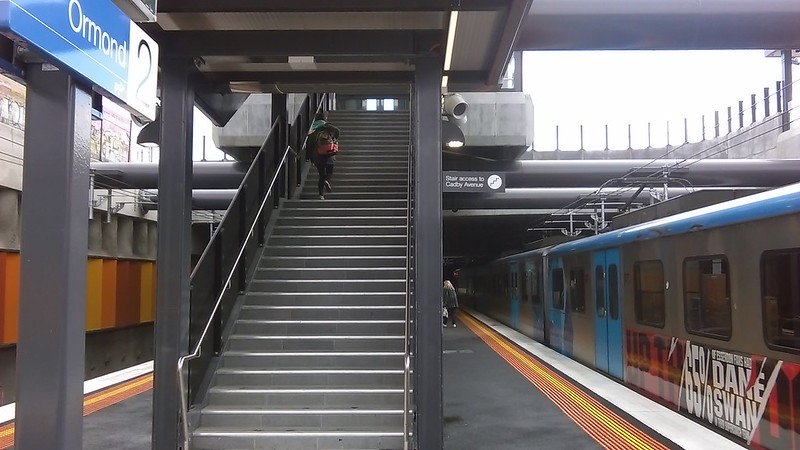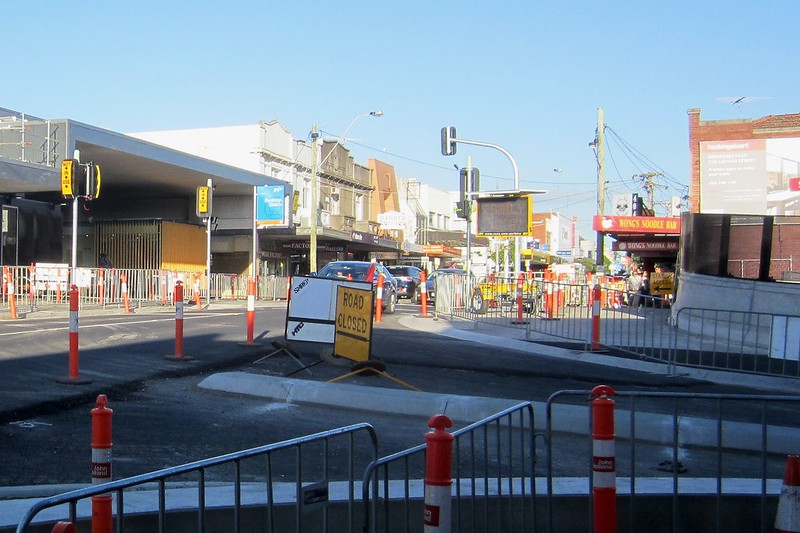This coming Saturday the new Bentleigh, McKinnon and Ormond stations are hosting a “family fun day” featuring a steam train. Should be… well, fun.
Edit: Here’s the steam train timetable:

(Hopefully they’ve checked if steam trains are okay climbing the higher-than-usual 2.5% (ish) gradient heading north out of Ormond station! I’d assume so, given the 2% standard is a relatively new requirement.)
At Ormond the entrance on the northern side of the road has recently opened. This is really helpful given North Road is a big arterial road, with some six lanes of traffic at 60 kmh.
That’s not so important at Bentleigh and McKinnon; only two lanes of traffic (at 40 or 50 kmh), and we’re getting pedestrian lights instead… which hopefully will be programmed to be very responsive to pedestrians.
But one of the things you notice is the non-station side of the bridge is a plain concrete wall, with a metal barrier on the top. You can see through the metal, but only just, and the whole thing is not beautiful — and I suspect could be a magnet for taggers. (See at right of photo, above.)
The Level Crossing Removal Authority is calling for artists to decorate the concrete walls.
This is a good idea. Turns out they’ve done much the same thing in Footscray on the Hopkins Street bridge, and as a strategy for keeping away tagging, it’s worked very well:
As with nearby Patterson station mural, hopefully this will help beautify the grey concrete, and prevent it being covered in graffiti. Or advertising, for that matter.



5 replies on “Plain concrete to be replaced by art”
I wouldn’t worry about the gradient Daniel – gradients above 2% are common all over the existing network and steam trains coped with them in the past.
This new 2% ‘standard’ seems to be about future-proofing the network for heavy freight trains. That’ll be important for Dandenong and the western suburbs lines – a little less so for Frankston (steel trains notwithstanding) but rather far-fetched for Rowville or Doncaster, where the standard serves only to inflate construction cost forecasts.
Pretty sure Melbourne Metro won’t be obeying the 2% limit. I gather that the earlier plan to run (vertically) between Swanston St and the Loop tunnels required 4% grades.
The trailing load limit for a single K class loco on a 2.5% (1:40) gradient is 300 tonnes. The second loco weighs 110 tonnes (assuming it doesn’t contribute), and the five or six short-W carriages weigh around 30-35 tonnes each. Basically, if the train is fine on the Eltham route it’ll be fine on the Frankston route.
I support the standard approach, for the just in case we may want to run a freight train down that way.
We do have a lot of industrial factories around the Rowville area, and could just be able to support a portlink superfreighter??
FWIW, having gradients above 2% doesn’t prevent you running freight trains. (It doesn’t on the Frankston line.) In the trade-off between fitting tracks to terrain and maximising achievable freight loads, 2% is just an arbitrary point that happens to match existing lines in the west of Melbourne where most freight travels. It’s what you want for the Melbourne to Sydney route if you’re going to put containers on superlong trains instead of on B-doubles up the Hume. But at the volumes likely in the eastern suburbs were rail to largely displace road freight, the odd 3% or even 4% grade won’t be a show stopper.
Anyway, one thing we can do without is bare concrete walls, whatever the grade. Public art FTW.
Well Glenhuntly station will have to go the same way as it’s neighbours Carnegie & Murrumbeena due to the fact that Neerim Rd used to be an old colonial canal (that still exists in a very large drainage pipe) & also the gas pipes & the No 67 tram line, make the underground option “not worth it” for Glenhuntly station.
The “nimbys” of Carnegie & Murrumbeena are totally ignorant of SE Melbourne’s history before the 1920s.
The old electric train line used to finish at Caulfield & then passengers had to go by steam train to Dandenong /Gippsland, that’s why the old level crossings were retained, for the steam trains.Then the young Caulfield council (around 1921) did some “contra” deal with the even younger Moorabbin council shifting all of it’s “unpleasant” necessities (like the aerodrome & rubbish tip in the Carnegie area, plus horse tanning/knackery yards) to the then young emerging suburban Moorabbin council, as Caulfield & Brighton were promoted to City status by the 1920s & wanted to dump off their dirty industries south of North Rd, which was then run by the Moorabbin council. Also, there used to be a steam train connecting the old pre-1959 Elsternwick station (which , like the Moorabbin station had a level crossing until 1959, when the Bolte Government had both stations grade-seperated) to the old pre-bridge Oakleigh station, which the Caulfield City council finally dismantled in the 1950s & sold off some of this railway land to housing developers & kept the rest for parks. So the “nimbys” might also realise, Melbourne’s population was much smaller (less than 2 million) during the 1940s & 50s, where the then Cain & Bolte state govts built gas pipes under the rail lines. Also not many families in the old SE suburbs during the 1940s & 50s had motorcars (approx 1 car per family) & most people those days got around by pushbike or trains. No one in the 1950s could envision China becoming a world superpower so quickly, which has played a major role in Melbourne’s rapid population growth in the past 20 years. Melbourne is no longer that “isolated” anymore as our northern neighbours (China & Japan) are now big time world players & Australia is in their time zones & backyard. We are technically the “Spain” of Asia these days, we are no longer some British colonial backwater, as we were back in the 1950s. The Carnegie/Murrumbeena “nimbys” & Dick Smith (of Australian Geographic) like to “paint” some mythological portrait of what Australia was alleged to have been like in the 1940s & 50s, but the reality (especially to the European migrants during the 1950s), Australia was then considered very “backward” and I think the “nimbys” still carry some of that “cultural cringe” to this day!